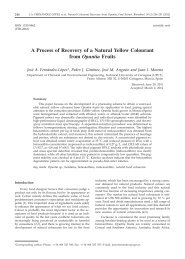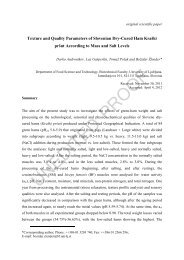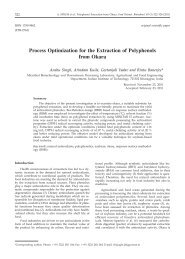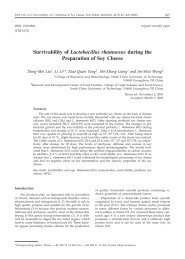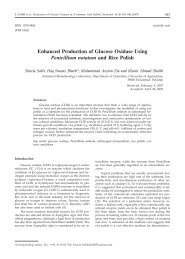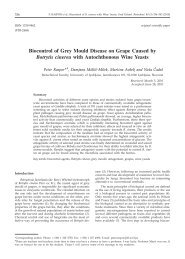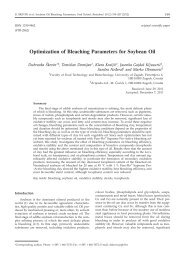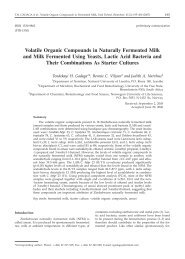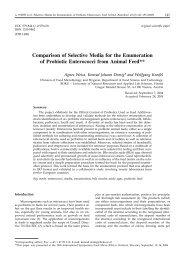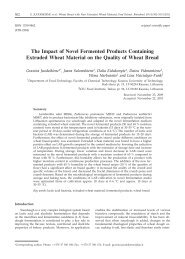Aerobic Degradation of Formaldehyde in Wastewater - Food ...
Aerobic Degradation of Formaldehyde in Wastewater - Food ...
Aerobic Degradation of Formaldehyde in Wastewater - Food ...
Create successful ePaper yourself
Turn your PDF publications into a flip-book with our unique Google optimized e-Paper software.
200 M. GLANCER-[OLJAN et al.: <strong>Aerobic</strong> <strong>Degradation</strong> <strong>of</strong> <strong>Formaldehyde</strong> <strong>in</strong> <strong>Wastewater</strong>, <strong>Food</strong> technol. biotechnol. 39 (3) 197–202 (2001)Fig. 4. <strong>Aerobic</strong> degradation <strong>of</strong> formaldehyde with the mixedculture <strong>of</strong> P. putida, P. cepacia and T. penicillatum <strong>in</strong> thesynthetic medium – biomass growth and changes <strong>in</strong> pHhyde degradation, i.e. <strong>in</strong> accumulation <strong>of</strong> formic acid,was relevant to enzymatic activity, or that unfavourablepH affected generation <strong>of</strong> formic acid, as confirmed byother authors (11).Over 48 hours <strong>of</strong> formaldehyde aerobic degradation,P. cepacia (Fig. 2) accumulated significantly lowerlevels <strong>of</strong> formic acid than P. putida (Fig. 1). For that reasonpH was not been affected significantly. P. cepaciawas capable <strong>of</strong> degrad<strong>in</strong>g formaldehyde over 48 hourswithout accumulation <strong>of</strong> formic acid. Therefore it maybe assumed that its enzymatic system was superior tothat <strong>of</strong> P. putida. The <strong>in</strong>crease <strong>of</strong> optical density (Figs. 1and 2) confirmed that formaldehyde and the accumulatedformic acid were used as carbon sources for thegrowth <strong>of</strong> P. putida and P. cepacia biomass.The selected T. penicillatum yeast stra<strong>in</strong> behavedsimilarly to P. putida. <strong>Formaldehyde</strong> was degraded <strong>in</strong> 36hours, formic acid was generated up to 24th hour <strong>of</strong>degradation and pH=6.0 was found to facilitate the use<strong>of</strong> formic acid and formaldehyde for synthesis <strong>of</strong> yeastbiomass (Fig. 3).With the use <strong>of</strong> the mixed culture, aerobic degradation<strong>of</strong> formaldehyde was completed <strong>in</strong> 18 hours (Fig.4). That was significantly faster than with the use <strong>of</strong> <strong>in</strong>dividualstra<strong>in</strong>s. Dur<strong>in</strong>g degradation, it was shown thatformic acid developed as the <strong>in</strong>termediate product, but<strong>in</strong> much lower concentrations than with <strong>in</strong>dividualstra<strong>in</strong>s. Changes <strong>in</strong> pH from 7.6 to 7.2 were favourablefor ma<strong>in</strong>ta<strong>in</strong><strong>in</strong>g enzymatic activity <strong>of</strong> both bacterialstra<strong>in</strong>s. That resulted <strong>in</strong> complete degradation <strong>of</strong> formaldehyde,without accumulation <strong>of</strong> formic acid, accompaniedby biomass synthesis.In a separate experiment the mixed culture <strong>of</strong> P.putida and P. cepacia showed equal pattern <strong>of</strong> formaldehydeaerobic degradation as the mixed culture <strong>of</strong> P.putida, P. cepacia and T. penicillatum. (Fig. 4). Therefore,the addition <strong>of</strong> T. penicillatum contributed to the formation<strong>of</strong> a flocculent mixed culture biomass that could beeasily separated from the medium (Figs. 5 and 6).The possibility for achiev<strong>in</strong>g high degree <strong>of</strong> formaldehydedegradation with the use <strong>of</strong> <strong>in</strong>dividual bacterialstra<strong>in</strong>s and yeast have been confirmed (4,7,11). Thereare no literature data, however, on aerobic degradation<strong>of</strong> formaldehyde with the use <strong>of</strong> mixed cultures conta<strong>in</strong><strong>in</strong>gbacteria and yeast.Fig. 5. Microscopic view <strong>of</strong> the mixed culture biomass conta<strong>in</strong><strong>in</strong>gP. putida and P. cepacia developed dur<strong>in</strong>g aerobic degradation(enlarged 16x40)Fig. 6. Microscopic view <strong>of</strong> the mixed culture biomass conta<strong>in</strong><strong>in</strong>gP. putida, P. cepacia and T. penicillatum <strong>in</strong> the floccularform dur<strong>in</strong>g aerobic degradation (enlarged 16x40)Regard<strong>in</strong>g formic acid degradation <strong>in</strong>dividual stra<strong>in</strong>sand the mixed culture performed efficiency as shown <strong>in</strong>the figures: P. putida – Fig. 7, P. cepacia – Fig. 8, T. penicillatum– Fig. 9, and the mixed culture – Fig. 10.All <strong>in</strong>dividual stra<strong>in</strong>s, and particularly the mixed culture,were capable <strong>of</strong> degrad<strong>in</strong>g formic acid with<strong>in</strong>18–24 hours, with the accompany<strong>in</strong>g growth <strong>of</strong> biomassand the <strong>in</strong>crease <strong>in</strong> pH.P. putida degraded formic acid (500 mg/L) over 24hours (Fig. 7) and P. cepacia over 12–18 hours (Fig. 8)




